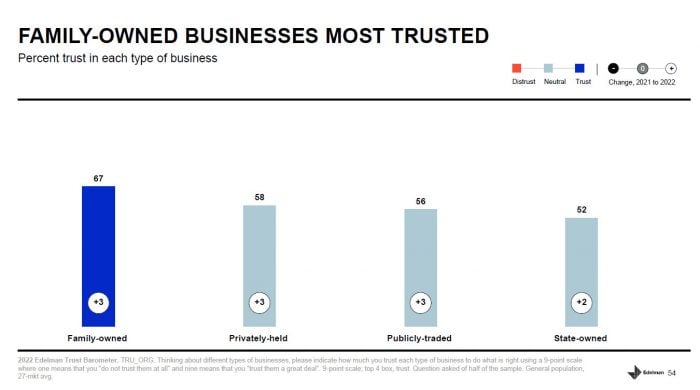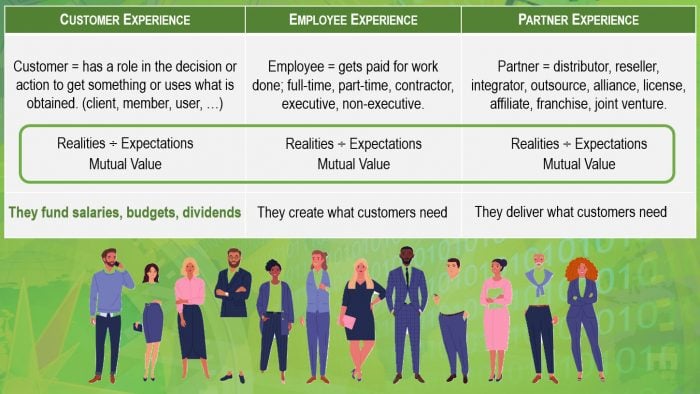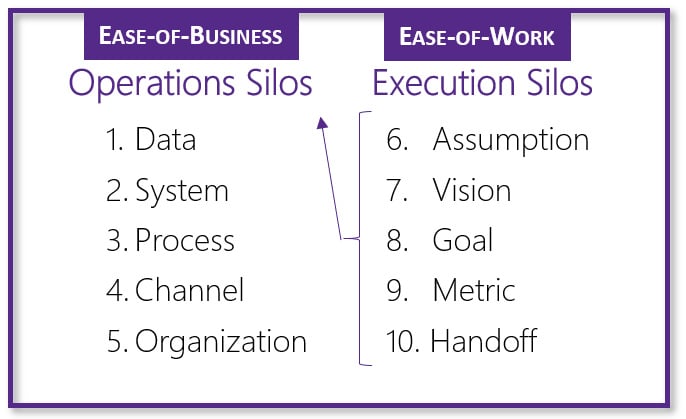 What seems logical in hard times may be opposite of what’s best for growth. When you’re in a pinch — instead of weakening customer experience, partner experience, and employee experience — you can strengthen value for all.
What seems logical in hard times may be opposite of what’s best for growth. When you’re in a pinch — instead of weakening customer experience, partner experience, and employee experience — you can strengthen value for all.
You can do this through 3 universal keys and by avoiding 4 typical pitfalls.
Key #1: You’re in Hard Times Together
Key #2: CX, EX & PX Goal is 1:1 Ratio
Key #3: Leverage Interdependencies
Pitfall #1: Shrinkflation & Inflation
Pitfall #2: Universal Budget Cuts
Pitfall #3: Converting Service to a Revenue Center
Pitfall #4: Increased Technology
Key #1: You’re in Hard Times Together
Keep in mind that both you and the other party are in distress when interest rates rise, supply chain and talent are uncertain, or political and social dynamics shift. In essence, you’re in it together with your employees, partners, and customers.
Today, the ongoing changes are particularly intense: everyone has gone through three years of fear, loss, deprivation, soul-searching, and emotional roller coasters.
As the saying goes: “What goes around, comes around”. Since you rely upon these three groups for your growth, it can be disastrous to damage your relationship strength (i.e. lifetime value) through avoidable mis-steps.
Key #2: CX, EX & PX Goal is a 1:1 Ratio
Success of Customer Experience, Employee Experience, and Partner Experience (CX+EX+PX) is a 1-to-1 ratio (or better) between their expectations and the realities they experience. This simplicity is powerful: (1) consistently set realistic expectations and (2) deliver accordingly. When you emphasize the 1-to-1 ratio, it’s easier to discern must-haves and nice-to-haves.
Key #3: Leverage CX, EX & PX Interdependencies
Leverage interdependencies among CX+EX+PX. While everyone claims that “happy employees make happy customers”, the real truth is that customer-aligned employees make the happiest employees and the most profitable customers and partners. This means:
- When both your non-customer-facing and customer-facing employees/executives/board are aligned to customers, this generates the happiest customers and happiest partners, who continually reward your brand.
- This is possible by clearly identifying your high potential, core-growth customers’ top expectations as your north star for who and how to hire, develop, review, reward, advance, and fine-tune — among your employees, partners, and leaders (execs, board, investors).
- Employees’ higher purpose is making a difference for customers. When they are engaged in preventing issues for customers, everyone wins.
- Common purpose reduces organizational silos, making employees happier and more productive, generating more value.
- Fewer issues make partners and customers happier and more productive, generating more revenue with higher profitability.
- Common purpose reduces organizational silos, making employees happier and more productive, generating more value.
To make these three keys a way of life in your organization, see practical advice in my last article: 6 CX Spirit Animals for Today’s CX Imperative of Trust.
These 3 keys lay the foundation for navigating hard times without “shooting yourself in the foot” in CX+EX+PX value growth.
Here’s how you can avoid 4 costly pitfalls — and instead, increase growth — in managing experience of customers, employees, and partners:
Pitfall #1: Shrinkflation, Skimpflation, and Inflation
The knee-jerk reactions when costs expand are to raise prices for customers, reduce pay and perks for employees, and tighten terms for partners. Product and service shrinkflation (reduced size) and skimpflation (reduced quality) are widespread this year, along with inflation (higher prices). In some cases, brands are doing this simply because they can. However, reducing value is anti-growth! In most cases, these mis-steps can (and should!) be avoided.
This pitfall hurts everyone because growth requires ongoing value generation. Reducing value is a slippery slope.
- It breeds customer distrust, resentment, and churn.
- When value decreases, it’s harder for partners to help you grow.
- Likewise, employees inevitably lose pay or jobs when value is reduced.
- Investors may be appeased for the short-term, but costs to regain customers, partners, and employees later on certainly delay or reduce future gains.
You can avoid shrinkflation pitfalls through experience management (XM) annuities.
In most cases, operational inefficiencies are at the heart of tactics like shrinkflation, skimpflation, and inflation. Whenever a 1-to-1 ratio fails, remedial CX+EX+PX costs multiply: negative word of mouth, returns/refunds, service staffing/technologies, escalations/remedies, churn, and higher loyalty enticements and acquisition costs.
Experience management annuities:
- Recapture remedial costs for a prevalent CX/EX/PX issue when you prevent its root cause.
- These recaptured funds generate value in perpetuity in two ways:
- Freeing-up otherwise perpetual expenses.
- Re-allocating freed-up funds to higher-value opportunities.
- Freeing-up otherwise perpetual expenses.
You can grow CX+EX+PX value by focusing on experience management annuities. Through this method, we reaped massive savings, trust, and growth. The list below is a small sample of XM annuities we achieved during the 11 years that I led customer experience company-wide at Applied Materials. You can do this, too. These gains contributed to sales velocity, profit margin expansion, retention, lifetime value, return on assets (ROA) and earnings per share (EPS).

Pitfall #2: Universal Budget Cuts
Cost-cutting typically ignores CX+EX+PX insights as its basis. Furthermore, CX+EX+PX investments are among the first on the chopping block. This stems first from ignorance of the 3 universal keys described above. It stems secondly from CX+EX+PX focused on remedial and superficial endeavors instead of experience management annuities. In most cases, these mis-steps can be avoided.
This pitfall hurts everyone because you rely on customers, employees, and partners for your growth. Organizational knowledge walks out the door, along with momentum you’ve been accruing. Relationship strength sags and a snowball effect occurs with employees, partners, and customers: higher costs for them, churn, and lower value for all.
You can avoid CX+EX+PX cost-cutting pitfalls by using CX+EX+PX insights as your north star to guide wise cost-trimming.
Therefore, your CX+EX+PX insights must go well beyond “likely to recommend”. Your collection of Expectations VoX and Realities VoX are equally important.
- Identify your high potential (core-growth) customers, partners, and employees.
- Discover their 2-3 top expectations (source of highest anxiety for their job-to-be-done). This can be done through text/voice mining of their comments, followed by validation.
- For every decision you make, ask: is this helping or hindering the top 2-3 CX+EX+PX expectations?
You can grow CX+EX+PX value by trimming costs that are at-odds with CX+EX+PX priorities. Experience management annuities alleviate significant cost pressure, as well.
Pitfall #3: Converting Service to a Revenue Center
When people contact your company, it seems logical to extend an offer to further engage. However, a Service inquiry generally signals failure of the experience before that point. This means your customer, partner, or employee making the inquiry is likely to be in a negative frame of mind. Even after successful resolution, it’s often inappropriate to up-sell and cross-sell in a Service call. In most cases, this mis-step can be avoided.
This pitfall hurts everyone because trust is damaged when people make decisions, either while feeling pressure about their situation or from the Service provider. Globally, people distrust more than 40% of privately owned firms and publicly traded firms, and more than 30% of family owned firms. This statistic from the 2022 Edelman Trust Barometer is based on 27 countries with a 9-point scale, where 9 = trust them a great deal, 1 = do not trust them at all, and “trusted” is the top-4 box (ratings of 6, 7, 8, and 9).

What is distrust costing you? How is it affecting your CX+EX+PX ROI? Significantly! Low trust means extra marketing expenses, longer sales cycles, more enticements (marketing and sales and loyalty), higher churn, higher cost to serve, and extensive remedial experience management investments. It’s a hamster wheel of increasing costs, which cannot be offset by converting Service to a revenue center.
You can avoid CX+EX+PX Service pitfalls by converting to 1-to-1 ratio management.
- Emphasize experience management annuities: highlight the root causes of Service inquiries, and then, expect originators of root causes to prevent recurrence.
- Avoid gaps in the 1-to-1 ratio: bring high visibility to the gap between Expectations VoX and Realities VoX. Then, bring high visibility to originators of the gap for:
- Preventing recurrence of gaps.
- Preventing occurrence of gaps.
- Preventing recurrence of gaps.
You can grow CX+EX+PX value by shifting from remedial Service and superficial experience management to proactively driving a 1-to-1 ratio in CX+EX+PX.
Pitfall #4: Increased Technology
In the quest to streamline and save time through digitalized experiences, surprisingly, your customers, partners, and employees may be required to take more time and trouble. Many technologies are over-hyped, promising far more than can be delivered.
For instance, a brand I’ve been loyal to for 20 years now uses AI for Service. When the self-help resources were insufficient for my situation, the voice bot tried several times to hear my name correctly, and then I had to go into another lengthy queue before getting live help. Overall, it was an epic CX fail. Inevitably, EX was affected as I vented to the employee who answered my call.
Ironically, the more you rely on technology for smooth experience journeys, the more coordination is required among your people. They set the parameters for digital experience. When the right hand doesn’t know what the left hand is doing, it’s a recipe for fiascos.
Execution silos are at the heart of operational silos. As an executive at Clorox said, “We were trying to do digital, and we realized we must first be digital“, meaning un-siloed. Extensive change management is needed, early and often, far prior to and during digital roll-outs. In most cases, these mis-steps can be avoided.
This pitfall hurts everyone because premature roll-out of digitalized customer management can rapidly sour CX+EX+PX. These turnoffs lead to more strain on your customer-facing people, negative word of mouth, and churn of customers, partners, and employees.
You can avoid CX+EX+PX technology pitfalls by ensuring relationship strength integrity.
- Charter your XM steering committee with reducing execution silos:
- Broaden perspectives by sharing VoX insights with everyone. Translate VoX implications to each work group’s interests. Suggest ways each work group can use VoX insights. Help them see how they are a cog in a bigger wheel.
- Expand motivations by giving high visibility to work groups who close the gap between Expectations VoX and Realities VoX.
- Nurture collaboration by emphasizing teamwork and issue prevention (1:1 CX+EX+PX ratio) in recognition and rewards.
- Build-in universality by instilling new habits for organizational learning (seeking and sharing lesson learned), transparency, and compatibility.
- Manage each execution silo by setting up the prerequisites outlined in my silo solution article series, Customer Experience Silos: How to Solve Them.
- Broaden perspectives by sharing VoX insights with everyone. Translate VoX implications to each work group’s interests. Suggest ways each work group can use VoX insights. Help them see how they are a cog in a bigger wheel.
- Test digital experiences extensively:
- Optimize digitalization for a 1:1 ratio with your core-growth customers, partners, and employees. You must win their favor.
- Use text/voice mining and session replays extensively as you roll-out digital experiences, and on an ongoing basis. Nip problems in the bud. Use agile principles to continually fine-tune your technology.
You can grow CX+EX+PX value by setting up checks and balances to ensure relationship strengthening as you deploy digital experiences for customers, partners, and employees.
Conclusion
Step back for a moment to discover the paradoxes of typical reactions to hard times. Stand in the shoes of your customers, and then your partners, and then your employees. When you see situations as they do, you’re more likely to find solutions that help everyone. When you think through the domino-effect of potential paths, you’re able to rise above the value-smashing norms.
Strive for ongoing value generation by respecting lifetime value of your relationships with your customers, partners, and employees. Minimize costs and maximize gains by making everyone’s goal a 1:1 ratio between what’s promised and delivered, both internally and externally. These principles will shift your trajectory — in hard times and good times — from value-rescuing and inadvertent value-smashing to ongoing value growth.
Image licensed to ClearAction Continuum by Shutterstock.
This article is part of a year-long CustomerThink Advisors series on How Stakeholder Experiences Drive Growth.
1. Customer Experience Growth Mindset for Executives
2. How Trust is the Basis for Value from Customer and Employee Experience
3. How to Motivate Executive Buy-in for CX, EX, and PX
4. Customer Experience Leaders Can Learn from Baseball
5. How to Cross-Pollinate Customer Experience, Employee Experience, and Partner Experience Growth
6. Rethinking Customer Experience Strategy: Forrester’s 2022 CX Index Dropped to 2020 Performance
7. Chief Customer Officers Can Stop Shrinkflation and Skimpflation
8. 6 CX Spirit Animals for Today’s CX Imperative of Trust






The three keys are essential. Every organization should be following your advice, especially regarding the pitfalls to be avoided or minimized. To optimize both stakeholder-centricity and business outcomes, there must be interdependencies and linkages between CX, EX, and PX: https://journals.sagepub.com/doi/10.1177/2394964320908454 Unfortunately, because most companies give this only lip service, and may even preach the value of linkage and integration to some degree, they don’t practice this effectively or consistently enough for it to make a strategic difference.
Thanks for your comment, Michael. This year in my weekly LinkedIn Live videos and many articles, I’ve advocated for those who lead customer experience, employee experience, and partner experience to learn from one another. There are so many parallels.
The Great Resignation might not have happened if EX management had taken a more customer-centric viewpoint of the employee experience. This means (a) managing EX within the context of gaps that paying customers feel between what’s promised and delivered and (b) managing EX with the employee’s viewpoint foremost, rather than the company’s viewpoint as central to employee surveys, etc.
A couple of articles shedding more light on the EX-CX connection are:
Is the World Happier with Customer Experience & Employee Experience?
Loyalty Boomerang
How to Cross-Pollinate Customer Experience, Employee Experience, and Partner Experience